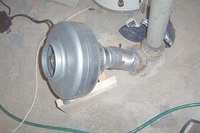Contributed by:
JonJaffer
Submitted: 03-04-2003
Images archived 2003
A common alternative to venting up the chimney
is venting into the sewer pipe. Depending on how your
house is built, if you push air into your sewer pipe,
the air may travel up through your house sewer
standpipe. However, it is possible to vent directly into
the actual sewer system.
Venting into the sewer
is generally safe. If someone is working in the sewer
nearby, they might smell the sweet pungent aroma of your
crop (Not likely at night), but they have no way to tell
where on the block it is coming from. Since the pipes
large enough to walk in are quite far away from
individual homes, the smell has lots of time to dilute.
[Editors note: the stinky sewer will also hide
your crop's odor up to a point. The sewer system itself
is sealed, but you should check nearby manholes covers
just incase for excessive blower noise and smell. The
undeground sewer system will also remove and cool
exhaust heat - excellent protection against infrared
detection.]

To start you will need to locate your
sewer pipe in your basement. This is the pipe coming
from your toilet(s) on upper floors.
Near the
basement floor, there should be a Y connection at an
angle, with a cap on it. Some houses have metal pipes,
other houses will have ABS or PVC plastic sewer pipes.

You will need a pipe wrench to remove the
cap. Sometimes, if the house is very old, you will need
to demolish the cap to get it off. You can buy a new one
later at the hardware store if you need to.
This
will reveal a hole 3 or 4 inches in diameter, depending
on where you live, it may even be another size.
CAUTION: Fumes from the sewer can be poisonous,
so make sure to use caution when removing the cap, and
once a fan is installed, make sure to keep it ON all the
time , so that there is no backflow into the home.
You will need to visit a hardware store, and
pickup the various connectors and aluminum flex ducting
to connect a fan to the hole. The most efficient fans
for this purpose are centrifugal inline fans, but a
squirrel cage fan will work too. The major difference is
power consumption - an inline fan will use about 1/4 the
electricity of the same size squirrel cage, they are
VERY efficient, but a little bit noisier.

The fan pictured here is 438 cfm, and
only uses 115 watts. The inlet and outlet ports are 6
inches in diameter. I use a reducer from 6" to 4", and
then I use 4" aluminum dryer ducting to the sewer hole,
and of course plenty o' duct tape!
Once you are
finished, you can test your work by standing outside the
basement door, and holding a lighter to the crack at the
bottom of the closed door. The flame should shoot
inwards, because air is being drawn from the upstairs.
If you have successfully create this 'negative
pressure' environment, there is no way that odorous grow
room air can enter the house, hence the smell is
contained!
[Editors note: the sewer contains
methane a smelly and potentially explosive gas! Keep
those gases away from your water heater pilot
light!]